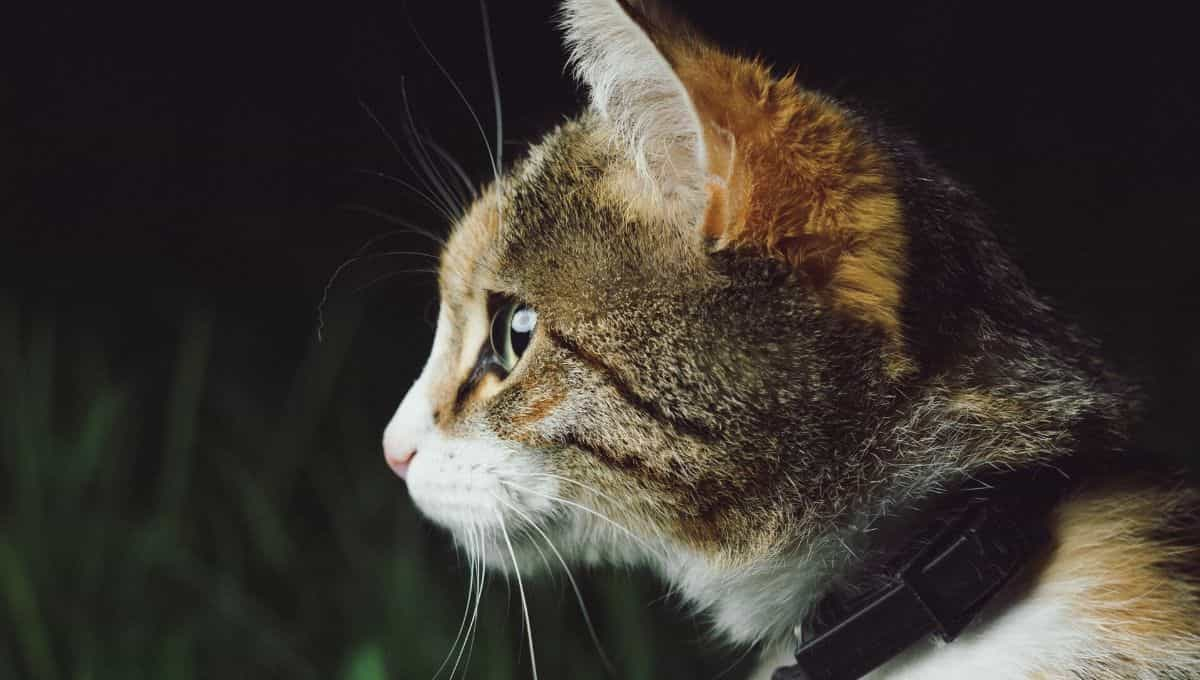Cat Shock Collars: What You Need to Know Before Buying

Everybody loves cats! Well, at least almost everybody does. People adore these furry little creatures, but sometimes they can get into a world of trouble due to their curious natures. Because of this, many pet owners resort to employing extreme behavioral modification methods like the use of cat shock collars to help train their cats.
While most people find this type of method to be cruel and inappropriate, some cat owners resort to using them as a training tool for their pets.
In this guide to cat shock collars we’re going to answer the questions of:
- Do shock collars work on cats?
- Are shock collars humane?
- Are shock collars inhumane?
- Is it safe and appropriate to use?
- Are shock collars really effective?
To answer these questions we need to really examine cat shock collars carefully and learn how they work. It’s our job as pet parents to make smart decisions that act to help, and not harm our furry feline friends.
What are Cat Shock Collars?
Cat shock collars, also known as cat training collars, are electronic devices that look similar to a regular pet collar, but have a small electronic device attached that delivers an electric shock to the cat wearing the collar.
In general, the small device attached to the cat training shock collar is either controlled by remote or is automatically programmed to deliver an electronic shock whenever a specific condition is met. The most common situation would be sending a shock to the cat whenever the microphone on the shock collar picks up a meow that’s louder than a specified decibel range.
How Do Shock Collars Work?
Many pet owners use electric shock collars for cats specifically as positive and negative reinforcement tools to aid in behavior modification.
The principal theory behind the device is that whenever pet owners notice their cat is doing or about to do an unwanted behavior, the owner can press a button in on the shock collar’s remote to deliver a signal to the collars electronic receiver, which will then release a specific amount of electricity that would shock the cat wearing the collar.
The electronic shock released by the collar is not intended to inflict pain but was designed to teach pets to associate the unpleasant feeling with the unwanted behavior, thus discouraging them to repeat that particular action.
Although the theory behind the use of cat shock collars makes sense, in the real world, this is simply not the case. Most of the time, cats will not understand the punishment they receive and it just causes confusion as well as stress for the cat.
Generally, cats do not respond well to pain or punishment and they really won’t understand what they are getting punished for. Many would argue that if for some reason a cat shock collar did work, what will happen if you removed it from the cat?
Would the cat simply go back to doing unpleasant behavior (like scratching your sofa or jumping on windows) because it noticed that the collar is gone?
In reality, cats will be cats, and no matter how much punishment they get, they will still repeat unwanted actions. The best thing that you can do is use positive reinforcement when your cat obeys you and stops doing unwanted behaviors.
Encouraging, praising, and rewarding your pet is a far better approach than shocking your cat to alter its behavior. Any form of animal cruelty has no place in training your pets.
Why Do Pet Owners Use Cat Shock Collars?
Some owners use cat shock collars because they believe that they’ve done everything they can to train their cats, but nothing seems to work. These people are usually uninformed owners that think that they can use cat shock collars (sometimes called cat silencing collars) as a fast and easy tool to train difficult pets.
Some pet owners also resort to the use of shock collars in combination with an invisible fence. Invisible fences are tools that allow your pets to roam around your backyard or any place in your house without worrying that the pet may go beyond your yard or enter a place where it is not allowed.
The theory behind this is that whenever your cat crosses the fence, it will receive a shock that forbids it from leaving the designated area. This method however may confuse your cat, because whenever he leaves the area and tries to come back, your cat will receive an additional electric shock from the collar on its way back, causing it to be scared to return to the designated area.
Overall, pet owners use shock collars simply because they want to get rid of their cat’s unwanted behavior, although in general it creates more problems and causes more harm than it helps.
List of Common Cat Behavioral Problems that Uninformed Pet Owners Try to Remedy with the Use of Cat Shock Collars
- Pet owners use shock collars for cats to stop meowing
- To stop their cat’s aggressive behavior towards other pets
- Prevent their cats from scratching home furniture
- Discourage their cats from jumping from places that may cause damage
- Stop cats from staying in places that are off-limits to pets
Different Types of Cat Shock Collars
In general, there are two types of cat training collars;
- Remote-controlled shock collars
- Unmanned shock collars.
Remote-Controlled Cat Shock Collars
This type of collar is usually a remote control device. The collar is controlled with a hand-held transmitter that allows the user to press a button in order to emit a signal directly to the collar’s receiver.
The remote enables pet owners to stop or prevent unwanted behavior by triggering an electronic pulse on the cat’s collar. Some remote-controlled cat shock collars are equipped with a warning button that when triggered will emit a sound on the cat’s collar that could serve as a warning to the pet that an electronic shock is about to be triggered if the cat doesn’t stop its action.
Unmanned Shock Collars
Unmanned shock collars are automatic shock collars that are designed to work effectively without any interference or controls coming from a user.
The two kinds of an unmanned shock collar are the following:
Motion-Sensitive Unmanned Shock Collars
This kind of unmanned shock collars acts in conjunction with an invisible wire that is frequently placed on the entrance of a prohibited space, area, or room. It is commonly used to prevent pets from entering or leaving a designated area.
Sound-Sensitive Unmanned Shock Collars
Sound-sensitive unmanned shock collars, sometimes referred to as cat meow collars are pet collars that are activated by a receiver, usually a microphone attached to the collar’s back that gets triggered to deliver a shock whenever a noise that is higher than its predetermined setting is reached.
Are Shock Collars Safe?

In theory, cat shock collars are created to be harmless for cats. Nevertheless, for most people, the notion of shocking your pet in order to change its behavior is cruel and basically similar to prodding a cat with a stick whenever it does something bad.
Do Shock Collars Hurt?
Many people would argue that when using shock collars on their minimum settings, they do not hurt the cat. However overuse and prolonged use of cat shock collars may eventually result in panic and even an allergic reaction on the part of your pet.
Thus, it is critical for cat owners that use shock collars on their cats to stop immediately and switch to safer and more humane methods of behavior modification.
Disadvantages of Using a Cat Shock Collar
Now that we know that it is pretty unsafe to use a shock collar on a cat, it’s important to also identify some of the disadvantages that may occur when we let our pets wear shock collars.
The Electric Shock
Even though pet owners can control the level of intensity of the shock that the collar emits, the unpleasant feeling that the cat will experience can result in fear and panic, which can cause your pet to become stressed and agitated.
The Fear
Shock training is risky because it can cause your cat to fear situations, people and objects that it thinks is associated with the pain it gets from its collar. It may even result in your pet to become aloof and immobile if you are not careful with its training.
The Confusion
The improper use of unmanned shock collars can cause your pet to become confused, because the unintentional or unnecessary shock that your cat will receive whenever the collar stops your cats from meowing or whenever the electric cat collar fence shocks the cat when it leaves the designated area can be misunderstood by your pet to be a punishment for something else.
No Positive Rewards
Using a shock collar alone to train your pets will not be effective if you don’t reinforce it with positive rewards whenever your pet does something good. Cat shock collars can only work to deter negative behaviors but it cannot reward your pet whenever it does something good.
Physical Danger
Cats are more active than other pets. It loves to jump, climb and move around a lot. Because of this constant movement, your cat’s collar can get stuck on an object, which can cause injury or even choke your cat to death.
Why Shock Collars Aren’t Recommended
Not only are shock collars considered needlessly cruel by some, but in parts of Europe, owning one to use on your feline is against the law.
While these collars are permissible in America, more and more cat lovers are against using them and here are the reasons why:
They Aren’t 100% Effective
And one of the reasons why is because, as we’ve mentioned previously, shock collars work on negative reinforcement without rewarding good behavior.
Cats are smart animals, more than we give them credit for. However, felines don’t respond well to being punished. Treats, praise, and petting may be more effective tools to modify your cat’s behavior.
Can a Shock Collar Kill a Cat?
As previously mentioned, the low-level voltage won’t inflict pain on your beloved pet. We’ve also discussed the psychological implications that invoke fear, anxiety, and stress in your animal.
What we haven’t looked at is that these shocks can also affect the nervous and cardiovascular system of a cat, so using these collars may prove fatal to cats with undiagnosed or preexisting conditions, or cause heart palpitations.
People Don’t Know How to Use Them Properly
They may only have trace amounts of electricity running through them, but they can be dangerous in the wrong or inexperienced hands.
If you don’t know how to use the device properly, you may be putting your cat at risk by overusing it.
In short, shock collars have been described as inhumane because there’s a higher chance of abuse or accidental misuse.
It Could Exacerbate Your Cat’s Behavior
If you think your cat’s behavior is unmanageable now, after using a cat collar, your feline might harbor negative feelings toward you, or become highly aggressive or more aloof towards their owners.
Cats have good memories and can act vengefully, finding new and creative ways to ruin your furniture and home.
Are There States in America That Have Banned Using Cat Collars?
Parts of the United Kingdom, particularly Wales and Scotland, have officially banned shock collars, and anti-cruelty leagues are proposing to outlaw them in England.
Denmark, Norway, Sweden, Slovenia, and Germany are other European countries that don’t sell the collars due to their bad press.
The only place in the US that could potentially outlaw these collars is Boulders, Colorado. A dog trainer native to the state has put forward a proposal to make them illegal. If it does get passed, it will be the first and only city on the entire continent to veto the device. That said, there’s a growing popularity to have them removed from society.
If I Can’t Use Cat Collars, What Can I Use?
If you feel that cat collars are your last resort, think again. There are numerous training techniques that we will discuss below. If these don’t work and the problems at home persist, a trainer or animal behaviorist may be of assistance.
It’s up to you to decide whether or not to continue using these collars, but it’s better to make a knowledgeable decision than to cause your cat undue stress because you aren’t well informed.
Recommended Alternatives to Cat Shock Collars
Using cat shock collars to control the bad behavior of your cats is not the best course of action to take. There are several other methods and products that can help you train your cat better.
To help you in looking for an alternative to cat shock collars, here are a few of our recommended products that are available online.
SSSCAT Cat Training Aid
The SSSCAT Cat Training Aid is an effective cat training tool that is used to discourage our cats from staying in places that we consider as off-limits to pets. It is a motion-activated canister that will deliver a quick burst of spray that harmlessly drives away pets from a specific area that we don’t want them in. The infrared sensor attached to the spray can monitor pet movements up to 3 feet away, making it effective to use for setting boundaries inside our house.
This cat training aid releases an odorless, stain-free and ozone-friendly spray that is harmless to both pets and children. It is easy to use and can be installed easily in various locations around the house.
This tool is a great alternative to cat shock collars in terms of keeping our cats from places that we don’t want them in. Furthermore, it can be used as a harmless and safe tool to teach our cats to avoid jumping, climbing or entering off-limit places.
Pros:
- Safe for both pets and human
- Odorless, harmless and environmentally friendly
- Small enough to fit small and hard to reach places
- The canister can be replaced easily when empty
- Motion-sensor has a good range (up to 3 feet)
- Can be easily installed
- A great alternative for invisible fences
- High-quality
- Nozzle automatically moves towards the direction the motion sensor detected the movement
Cons:
- Battery not included (Needs 4 AAA batteries)
- Can only be used indoors
- Each canister can only release approximately 80-100 spray
ScatMat Indoor Pet Training Mat
The ScatMat Indoor Pet Training Mat is an effective tool to train your cats from entering or staying in places that you don’t want them in, such as bedrooms, sofa, kitchen countertop, window sills, etc.
This cat training tool delivers a harmless and safe static pulse whenever your pet steps or enters the training mat. The 3-second mild pulse that your cat will receive will train your cat to not enter or stay in the area where the mat is located.
The tool can be used as both a deterrent for off-limit places and also an anti-scratch tool that prevents your cat from scratching the furniture in your home. Moreover, because of its flexible design, it can be used to prevent cats from jumping or staying in your window sills and even prevent it from leaving the house through your windows.
Pros:
- Flexible design (5 available designs – you can also combine it with one or more mats to cover a bigger area)
- Customizable settings (can be set to low, mid or high pulse)
- Safe and harmless for pets
- Built-in Monitor for training: You can count the number of times your pet tried to cross the mat using the blinking light
- Can be stored easily
- Easy to install in different areas
- Long battery life (approximately 3 months)
Cons:
- Can only be used indoors
- Has to be turned on and off manually
Emmy’s Best Cat Scratch Deterrent Spray for Kittens and Cats
The Emmy’s Best Cat Scratch Deterrent Spray for Kittens and Cats is a spray formula that is used to prevent cats from scratching furniture and other objects in your home, as well as train your cats to stay away from areas that you don’t want them in.
The fragrance of the spray used by this cat training tool is hated by cats but is relatively harmless to them. Its smell discourages your pet from loitering in areas where it is sprayed and thus, preventing scratches on objects located in that area.
Although the smell is hated by cats, it is non-toxic and safe for plants and other furniture in your home. Moreover, it smells pleasant to humans because the formula contains lemongrass and rosemary oil.
This training spray is a good alternative to cat shock collars because it is harmless, handy, and easy to use. All you need to do is constantly spray it on whatever area or object that you want to protect from your cat and it will defend it from your naughty pet.
Pros:
- Safe and non-toxic
- Handy and simple to use
- Harmless for pets, plants, and objects in your house
- The smell is pleasing to humans
- Can be used on any location or object
Cons:
- Doesn’t work instantly (You need to spray 3-4 times daily for the first 2 weeks)
Sofisti-Cat Scratch Deterrent Tape
The Sofisti-Cat Scratch Deterrent Tape is an anti-scratch deterrent tool that is used to train cats from scratching surfaces and objects that are protected by the tape. Its double-sided sticky surface helps in training your cat to avoid scratching the protected area due to the unpleasant sticky feeling that it will get whenever it scratches the tape.
The deterrent tape is safe and harmless to both your furniture and your cat. It is ideal to use on sofas, couches, drapes, beds, and armchairs. The tape’s clear and transparent design helps it from being discovered by your pet and prevents it from ruining your stylish decor.
Pros:
- The tape can cover a lot of areas
- Harmless to cats and furniture
- Can easily be installed and removed
Cons:
- Not suitable for bonded or faux leather
Final Words About Cat Shock Collars
We strongly recommend that you don’t use cat shock collars to correct the behavior of your pets. The use of these collars is cruel, unsafe, and not effective when it comes to training your cats.
It is always better to use positive reinforcement when correcting bad behaviors with pets. If you’re still have trouble, try one of our aforementioned and safe alternatives to cat shock collars.
With all things said it’s your responsibility as the pet owner to ensure the safety and well being of your cats. You’ve taken an awesome first step in educating yourself on the topic of cat shock collars, so now we encourage you to put your newfound knowledge to good use by using positive reinforcement and safe cat training methods.







